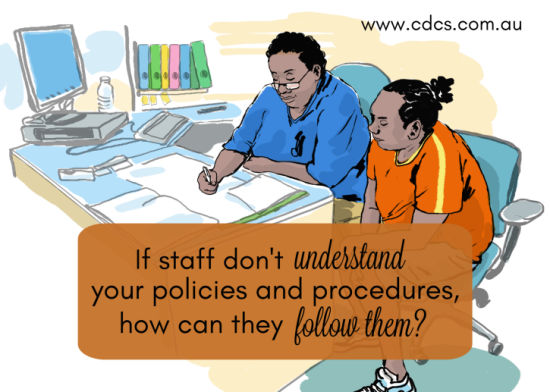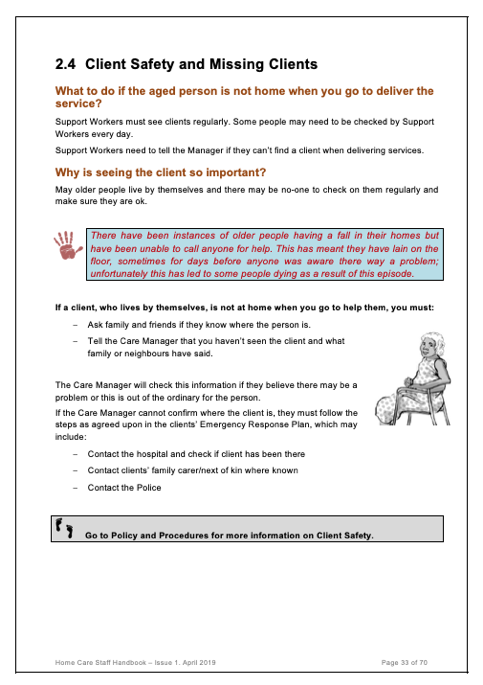Last week, we looked at the importance of having policies and procedures that are up to date, appropriate, that reflect your operational environment, and support the delivery of quality outcomes. But it’s not enough to just have a set of policies that management are aware of; all staff members need to understand the policies and procedures that are relevant to the role they play within your organisation.
So how do you ensure that staff have access to and an understanding of relevant policies?

What is becoming clear from evidence to the Aged Care Royal Commission is that it is the responsibility of management to ensure that policy and procedures are appropriate to the organisation's needs. Management also need to ensure that staff are fully cognisant of, and actively practising the policies and procedures that are in place.
I personally don’t like the practice of leaving a copy of a policy on the staff room table, or pinned to the noticeboard, which staff are expected to read and sign off that they have read and understood it. In my experience, many staff simply sign the piece of paper after skimming through the policy, or sign off without really reading it at all. Sure, it covers the requirement that staff are provided information about the policy, but does it really move your service and workforce forward?
How can management ensure that staff are actively practising the organisation's policies and procedures?
One way is to choose a policy and discuss what it means and the relevance and/or application for a few minutes at your next staff meeting. You could ask staff to read through the policy prior to the meeting if this is appropriate. During the meeting you could highlight sections of the policy and discuss the relevance to staff and their roles.
You’re likely to find that staff obtain a better understanding of the policy and the reason it exists. This is also a good opportunity to discuss any issues that staff might identify with the policy, clarify any aspects they are unsure of and may help identify areas of the policy that need to be updated.
Making it real
Of critical importance is that management and staff across the organisation can understand and enact the policies and procedures when it counts. They test what is written actually works.
Donna was recounting the other day her role in a recent Country Fire Authority training drill – testing a new suite of Emergency Management Procedures. The scenarios used were a great way of testing what did and didn’t work and what needed further revision.
The process of working through real life examples and testing how the ‘rubber meets the road’ showed up strengths and weaknesses, as well as how people react differently in situations. It’s likely that your team will interpret even clearly written procedures differently, so the value in ‘working it through’ and then debriefing at the end of a drill or group discussion will have incredible value.
Utilise an Incident or Action
If something has happened in the workplace, perhaps an accident, or you plan something such as an outing, use this as an opportunity to highlight a policy or procedure.
A Home Care Manager I was talking to the other day was lamenting at how reticent his support workers were in calling an ambulance if they found a client in distress and in need of urgent first aid. They would ‘call the office first’, contrary to organisation procedure. After discussing this further, it was clear that there was a disconnect between the written procedure and staff action. Staff also felt unsure of their authority.
The solution involved a couple of layers including:
- discussions at staff meetings and additional training on work practices relating to clients in distress, using relevant examples of staff actions and client outcomes;
- reinforcing with staff their authority and direction to call an ambulance if they believed it was the appropriate action; and
- providing reassurance to staff that the organisation would back their decision. As the Manager stated, he would rather deal with a cranky client than a coroner!
What about your staff handbook?
A staff handbook should be a plain English version of key policies and procedures that specifically relate to the role of the worker. If you want your staff to embrace and follow your policies and procedures, you need to make them easy to understand.
Many policies are written in a way that supports audit requirements or perhaps wider organisational conditions, and usually seeks to use a minimum amount of paper. However, this may mean that they contain a large amount of background or additional information that bogs down the reading flow. The issue is often compounded when staff are from a non-English speaking background, and the policy is written in plain text in a small font size.
Instead of merely compiling the relevant policies into a staff handbook, you may wish to distill the essence of a policy or procedure into a much shorter paragraph and reference the policy. Add more white space, relevant images and make the text a larger font size to make it easier to read. Provide instructions in simple bullet point format.
For example, you might have a policy about client safety which outlines key responsibilities. This might be presented as in the following example:

The information is presented in a way that is short, easy to understand, with enough information to explain the importance of the policy and plenty of white space to facilitate easy reading.
But what if your staff have difficulty with reading and comprehension?
Create an audio visual policy manual
Another way to help staff understand your policy suite is to have the policies video recorded. This is a tactic we are currently undertaking with one organisation that have a number of staff from a non-English speaking background.
The videos don’t have to be perfect and you can record them on a smart-phone, although do ensure that the audio content is of good quality, as people tend to accept lower picture quality over poor audio.
Use scenarios to explain the policy. We all love a good story and stories or case studies help to contextualise the policy. If you have a number of staff from the same language group, you may wish to record the policies in the main language to assist where English is not understood well.
We hope that this article has been helpful in reinforcing that ‘you are not alone’ when it comes to making policies and procedures relevant, meaningful and understood. There are a range of approaches that can be taken to make this work better for you and your team.
If you need assistance with developing an easy to read staff handbook drop us a line via our contact page, or for access to a set of plain English policies and procedures and other resources that help you meet your organisation needs in a cost effective way, you can find further information on our Resource Hub Membership site.
If you found this article interesting, please share it with others in your network who may also gain something from reading it.
- Aged Care Packages – what's in the box? - February 16, 2024
- 11 Ways to Make Your Progress Notes Better - September 22, 2023
- Vulnerable Clients – Who are they? - July 14, 2023



